Biological Classification | General Awareness for SSC CGL PDF Download
What is Biological Classification?
The process of grouping together various organisms according to their similarities, dissimilarities and phylogenetic descent is known as biological classification.
- There have been various attempts to classify organisms. The earliest was by Aristotle, who classified plants into herbs shrubs and trees. He classified animals into two groups, based on the presence and absence of red blood. Linnaeus gave the Two Kingdom system of classification and divided living organisms into Plantae and Animalia.
- R.H. Whittaker proposed the Five Kingdom system of classification and classified organisms, based on cellular structure, complexity, mode of nutrition, phylogenetic relationship and ecological role performed by them.
- Whittaker divided organisms into Monera, Protista, Fungi, Plantae and Animalia.
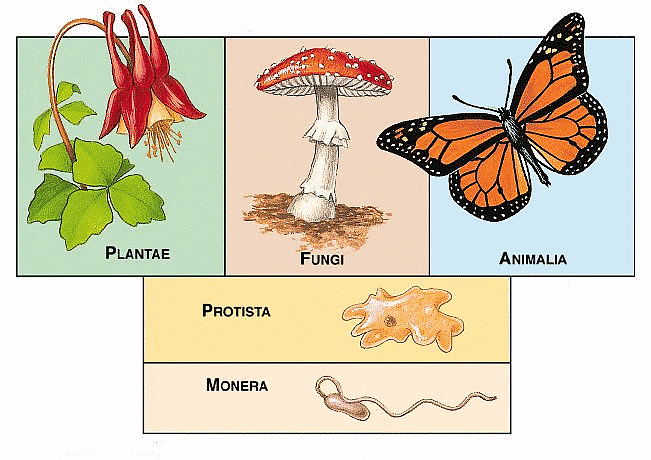 Five Kingdom Classification by Whittaker
Five Kingdom Classification by Whittaker
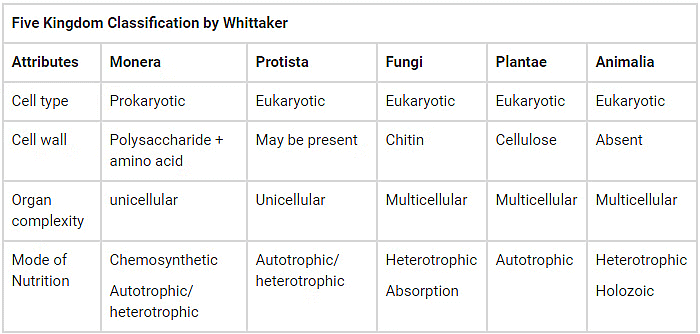
1. Kingdom Monera
- This group includes all kinds of bacteria, having a prokaryotic cell.
- The cell does not contain a nucleus.
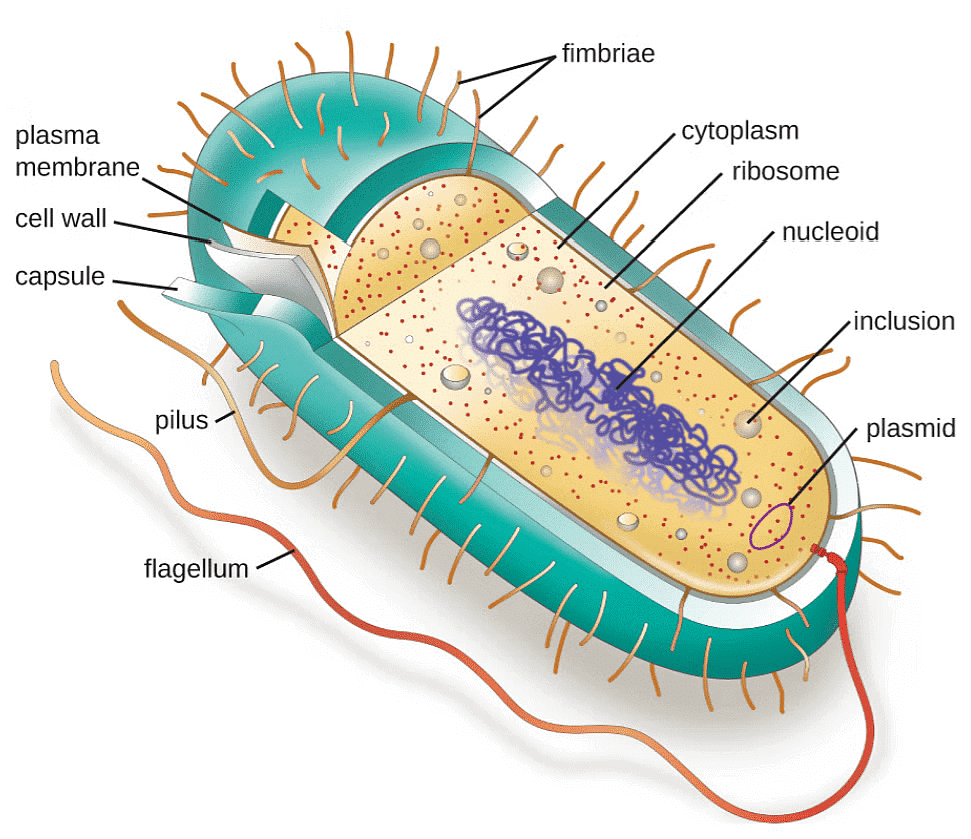 Kingdom Monera: Bacteria Cell Structure
Kingdom Monera: Bacteria Cell Structure
- There are different shapes of bacteria present; spherical- cocci, rod-shaped- bacillus, comma- vibrio and spiral- spirilla.
- They mainly reproduce by fission, spore formation under unfavorable conditions, and also by DNA transfer from one bacterium cell to another.
- Mycoplasma lack a cell wall and are among the smallest free-living bacteria; they can survive in aerobic or anaerobic conditions.
- Archaebacteria – These bacteria inhabit extreme environments such as salty lakes, marshes, and hot springs. They are classified as halophiles, methanogens, and thermoacidophiles, respectively
- Methanogens are present in the gut of ruminants and produce biogas.
Staining of Bacteria
Christian Gram, a Danish bacteriologist from the 19th century, developed a method to differentiate bacteria by staining them. Based on their color adaptation during the staining process, he categorized bacteria into Gram-positive and Gram-negative types.
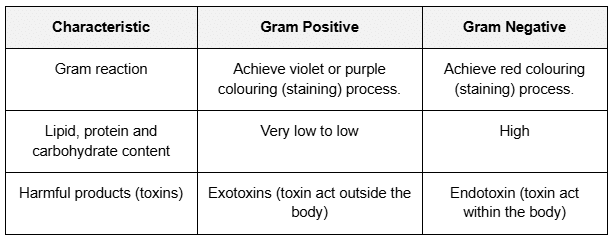
Nutrition in Bacteria
- Energy Requirements and Metabolism:
- Bacteria can be either autotrophic (self-food producing) or heterotrophic (obtaining food from other sources).
- Types of Heterotrophic Bacteria:
- Saprophytic Bacteria: Depend on dead organic matter.
- Symbiotic Bacteria: Form associations with other organisms.
- Parasitic Bacteria: Obtain food from other organisms.
Reproduction in Bacteria
- Asexual Reproduction:
- Occurs through vegetative methods and spore formation.
- Binary Fission: The common means of vegetative reproduction.
- Some bacteria reproduce by budding, e.g., yeast-like bacteria.
- Sexual Reproduction:
- Proven by Lederberg and Tatum in 1946.
- Transformation: Bacteria exchange genetic material, first observed by F. Griffith in 1928.
- Conjugation: Bacteria exchange genetic material through a conjugation tube, a process given by Lederberg and Tatum in 1946.
- Transduction: Bacteria exchange genetic material through bacteriophages, explained by Zinder and Lederberg in 1952.
Mycoplasma (Joker of Microbiology)
- Discovered by Nocard and Roux in 1898.
- Characteristics:
- Smallest bacteria, lack a cell wall, aerobic, non-motile, and pleomorphic (can change shape).
- Prokaryotic organisms containing both RNA and DNA.
- Also known as PPLO (pleuropneumonia-like organisms).
Economic Importance of Bacteria
- Bacteria cause various diseases in plants, animals, and humans.
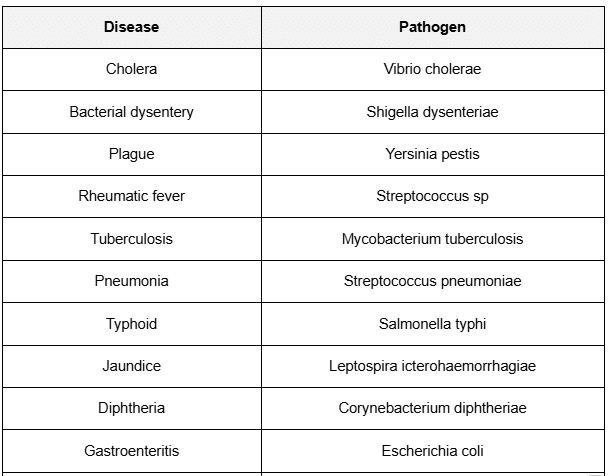 Human Diseases Caused by Bacteria
Human Diseases Caused by Bacteria
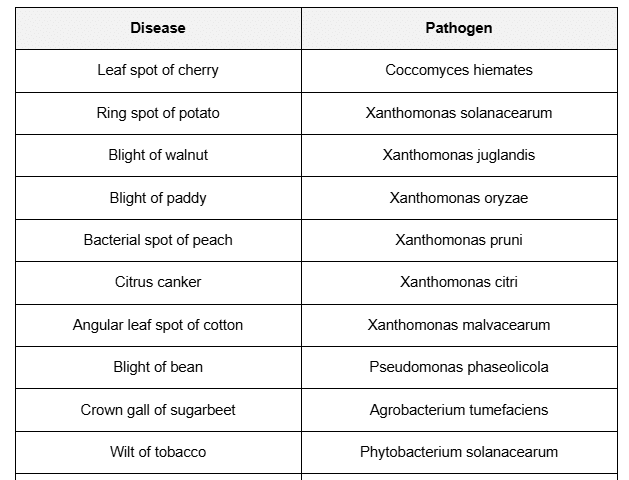 Plant Diseases Caused by Bacteria
Plant Diseases Caused by Bacteria
2. Kingdom Protista
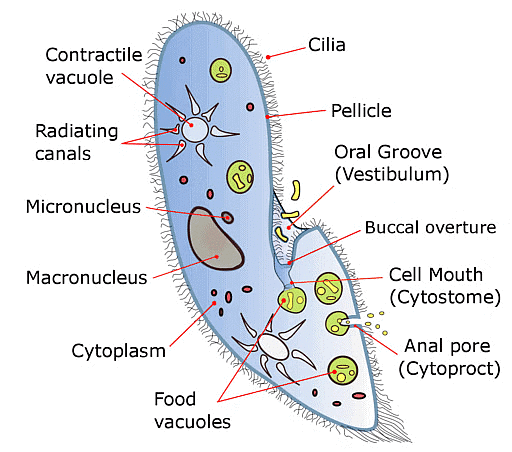 Kingdom Protista: Eukaryotes
Kingdom Protista: Eukaryotes
- The group includes unicellular eukaryotes.
- Photosynthetic protists exhibit characteristics of both plants and animals, acting as a link between them.
- They contain a well-defined nucleus and other membrane-bound cell organelles.
- They include protozoan, slime moulds, chrysophytes, dinoflagellates and euglenoids.
Chrysophytes
- Include diatoms and desmids (golden algae).
- They are mostly photosynthetic and have indestructible cell wall due to the presence of silica.
- The cell wall makes two thin overlapping shells, which fit like a soapbox on the outer surface.
- Diatomaceous earth is the deposit of the cell wall that gets accumulated. It is used for filtration and polishing.
Dinoflagellates
- They are photosynthetic and marine.
- They are found in many colours like yellow, green, red, blue, brown, according to the pigment present.
- Stiff cellulose plates are present on the cell surface.
- They multiply rapidly and cause red tide.
- Many dinoflagellates emit blue-green light and are bioluminescent.
Euglenoids
- They are photosynthetic flagellated protist.
- They are a link between plants and animals. They perform photosynthesis but lack a cell wall.
- The characteristic feature is the presence of pellicle, a protein-rich layer, which makes their body flexible.
- In the absence of sunlight, they feed on small organisms and behave as a heterotroph.
Slime moulds
- They are saprophytic protists feeding on organic materials from decaying twigs and leaves.
- Aggregation of slime moulds is called plasmodium, which they form under favourable conditions.
- Under unfavourable conditions, fruiting bodies containing spores develop at the tip of plasmodium.
- These spores can survive for very long under adverse conditions and have true walls.
Protozoans
- The group contains all the unicellular, eukaryotic, heterotrophs, which are parasites or predators.
- These are divided into 4 major groups:
- Amoeboid- They are characterised by the presence of pseudopodia, which are used for movement and catching of prey, e.g. Amoeba. Marine amoeboids have silica shells. Some of the amoeboids are parasites, e.g. Entamoeba histolytica causes amoebic dysentery.
- Flagellated- They are characterised by the presence of flagella. Some of them are parasites causing various diseases, e.g Trypanosoma causes sleeping sickness.
- Ciliated- They have thousands of cilia on their body surface. The coordinated movement of cilia helps in steering the water having food into the gullet (body cavity, which opens outside the body surface), e.g. Paramoecium.
- Sporozoans- They are characterised by the formation of spores, which is the infectious stage, e.g. Plasmodium.
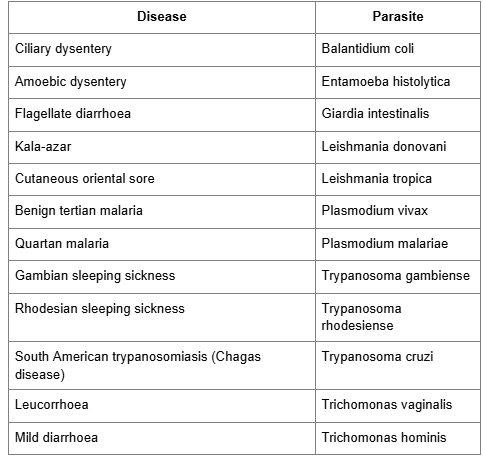
3. Kingdom Fungi
- Fungi are cosmopolitan and found everywhere.
- They are heterotrophic and get their nutrients by absorption.
- Their cell wall is made up of chitin or fungal cellulose.
- Their mode of nutrition is saprophytic, parasitic or symbiotic and the main food reserve is glycogen.
- Vegetative reproduction is by fragmentation, budding or fission.
- Asexual reproduction is by spore formation such as conidia, zoospores, and sporangiospores.
- Sexual reproduction is by oospore, ascospore or basidiospore formation in distinct fruiting bodies.
- In sexual reproduction, plasmogamy (fusion of protoplasm) is followed by karyogamy (fusion of nuclei).
- In basidiomycetes and ascomycetes, plasmogamy is not immediately followed by karyogamy, resulting in a distinct dikaryon (n+n) cell having 2 nuclei per cell.
Some Important Fungi
- Yeast- used in fermentation to make cheese, bread, and beer.
- Penicillium- antibiotics source.
- Puccinia- causes wheat rust.
- Ustilago- causes smut disease.
- Symbionts- Lichens (symbiotic association of fungi with algae), Mycorrhiza (symbiotic association of fungi with roots of green plants).
- Rhizopus- the bread mould.
- Albugo- the parasitic fungi on mustard.
- Neurospora- extensively used in genetic and biochemical work.
- Truffles and Morels- edible and are considered a delicacy.
- Agaricus- edible as well as poisonous species.
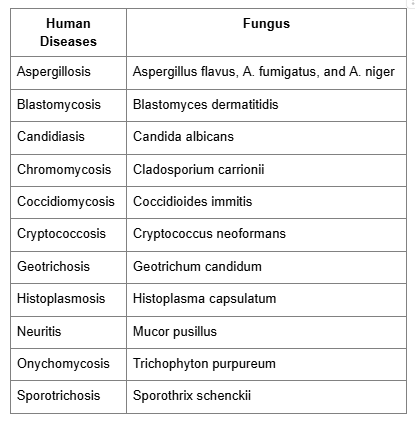 Human Diseases Caused by Fungi
Human Diseases Caused by Fungi
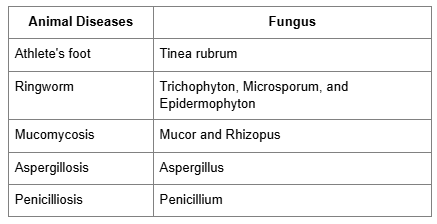 Animal Diseases Caused by Fungi
Animal Diseases Caused by Fungi
4. Kingdom Plantae
- Mostly autotrophic, chlorophyll-containing, eukaryotic organisms.
- Characterised by the presence of rigid cell wall made up of cellulose.
- Some plants are partially heterotrophic such as Insectivorous (Venus flytrap, Bladderwort) and parasites (Cuscuta).
- Kingdom Plantae are characterized into Flowering and Non-Flowering plants.
- Kingdom Plantae includes Algae, Bryophytes (Mosses and Liverworts), Pteridophytes (Ferns), and Spermatophytes (Gymnosperms and Angiosperms).
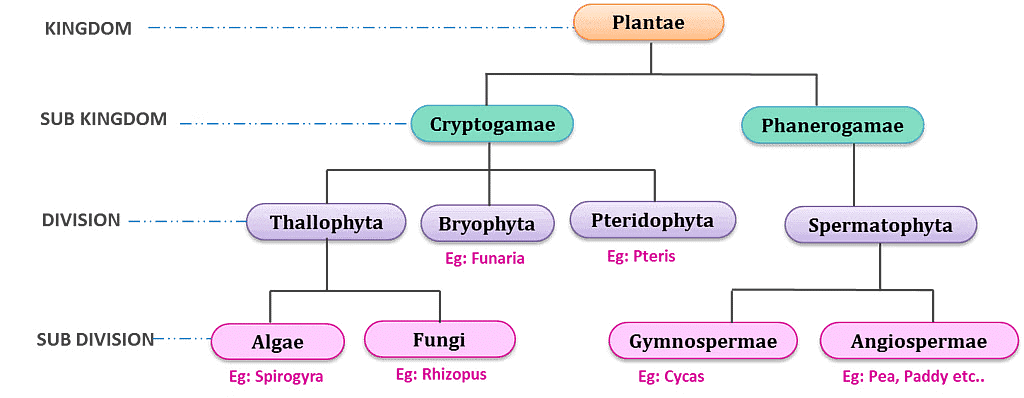
5. Kingdom Animalia
- Animals are classified on the basis of common fundamental features like the cellular arrangement, symmetry of the body, presence or absence of the coelom, specific features of the digestive, circulatory and reproductive system
- All the heterotrophic, eukaryotic and multicellular organisms are included in the Kingdom Animalia.
- They lack a cell wall.
- Cellular level of organisation: cells arranged as loose aggregates, present in Porifera (sponges)
- Tissue level of organisation: cells performing the same function form tissues, present in coelenterates
- Organ level of organisation: tissues grouped together to form an organ, which performs particular function, e.g. Platyhelminthes
- Organ system level of organisation: few organs coordinatively perform a certain physiological function, e.g. Annelids, Arthropods, Molluscs, Echinoderms and Chordates
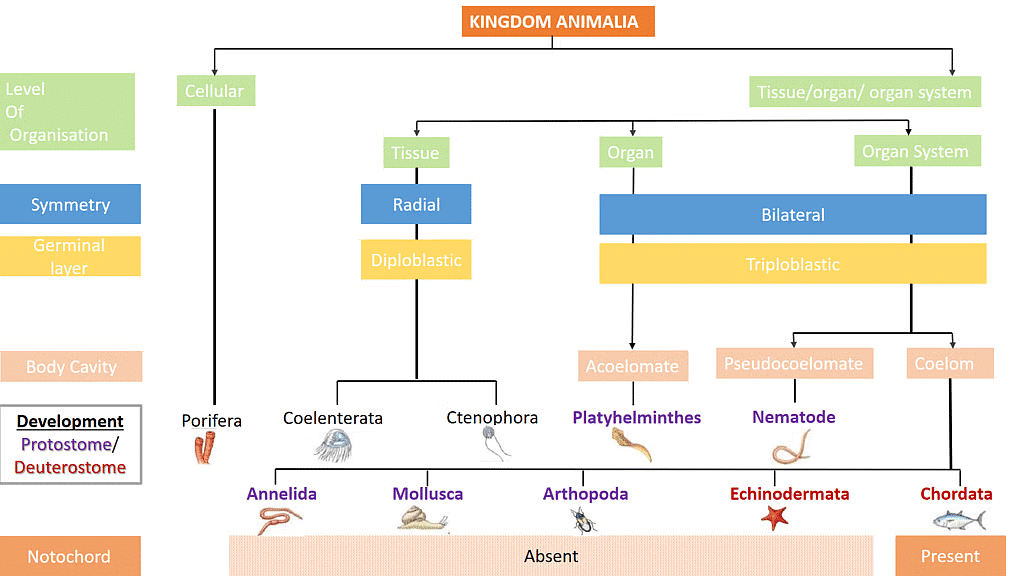
Acellular organism & lichens, not covered in Whittaker's Five-Kingdom Classification:
Viruses
- Dmitri Ivanowsky gave the name “virus” to the causal organism of tobacco mosaic disease (TMV).
- Beijerinek called the fluid extracted from diseased plants of tobacco, “Contagium vivum fluidum” and observed it as being infectious to healthy plants.
- Stanley crystallised TMV (tobacco mosaic virus) for the first time.
- They are acellular containing nucleic acid core (either DNA or RNA), which is surrounded by a protein coat called the capsid.
- Viruses use the host machinery to multiply inside the host cell, they exist in a crystalline form outside the host cell.
- They are obligate parasite and cause various diseases in plants and animals, e.g. common cold, AIDS, polio, mumps, measles, chickenpox, etc. in animals and various mosaic diseases in plants such as tobacco, cucumber, tomato, etc. leaf curling, yellowing of vein, etc.
- Viruses that infect plants have single-stranded RNA.
- Bacteriophages, viruses infecting bacteria have double-stranded DNA.
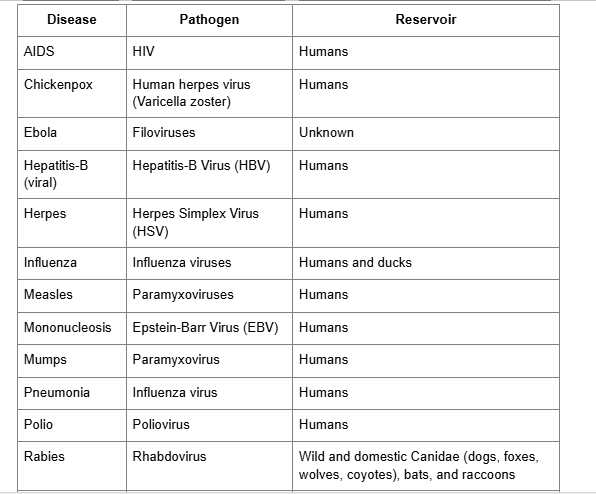 Diseases Caused by Virus
Diseases Caused by Virus
Viroids
- They are the smallest infectious agents found. They consist of nucleic acid but lack a protein coat.
- Diener discovered viroids as the causative agent of potato spindle tuber disease; they are free RNA molecules lacking a protein coat.
Prions
- They contain abnormally folded proteins and have a size similar to viruses.
- They can change the shape of normal proteins by transmitting their misfolded proteins.
- They cause many neurodegenerative diseases, e.g. bovine spongiform encephalopathy (BSE) in cattle and Cr-Jacob disease in humans.
Lichens
- They are a symbiotic, mutually beneficial association of algae (phycobiont) and fungi (mycobiont). The alga is autotrophic and provides food, whereas the fungus provides protection and shelter.
- Lichens do not grow in polluted areas so they are a good pollution indicator.
|
448 videos|1497 docs|288 tests
|
FAQs on Biological Classification - General Awareness for SSC CGL
| 1. What are the five kingdoms of biological classification according to Whittaker's Five-Kingdom Classification? |  |
| 2. Which kingdom includes acellular organisms and lichens that are not covered in Whittaker's Five-Kingdom Classification? |  |
| 3. What is the importance of biological classification in understanding the diversity of living organisms? |  |
| 4. How does biological classification help in identifying evolutionary relationships between different species? |  |
| 5. Can the classification of organisms change over time as new information is discovered? |  |





















